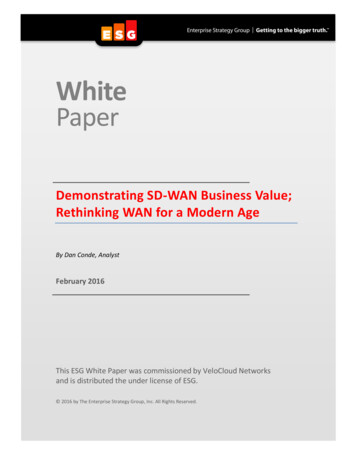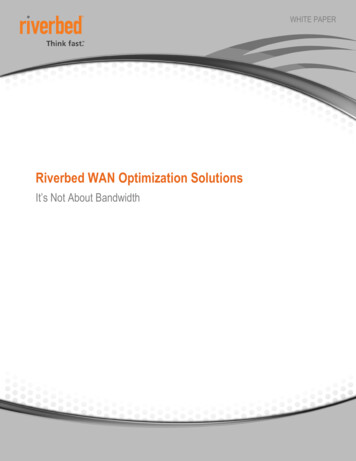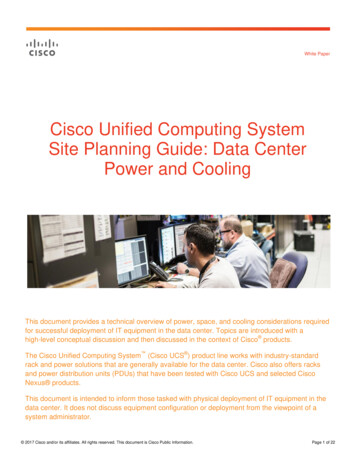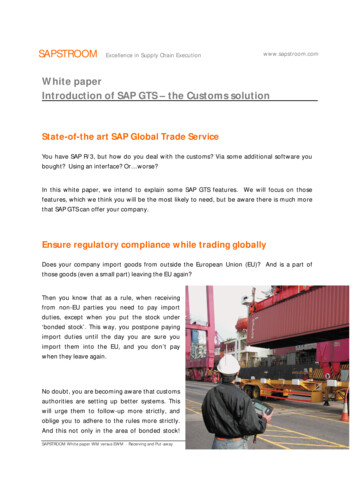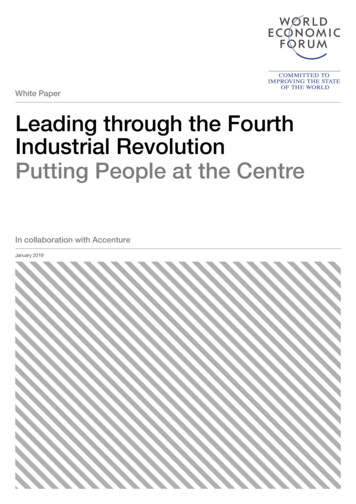
Transcription
White PaperLeading through the FourthIndustrial RevolutionPutting People at the CentreIn collaboration with AccentureJanuary 2019
World Economic Forum91-93 route de la CapiteCH-1223 Cologny/GenevaSwitzerlandTel.: 41 (0)22 869 1212Fax: 41 (0)22 786 2744Email: contact@weforum.orgwww.weforum.org 2019 World Economic Forum. All rightsreserved. No part of this publication may bereproduced or transmitted in any form or by anymeans, including photocopying and recording, orby any information storage and retrieval system.This white paper has been published by the World Economic Forum as a contribution to a project,insight area or interaction. The findings, interpretations and conclusions expressed herein are a result of a collaborative process facilitated and endorsed by the World Economic Forum, but whoseresults do not necessarily represent the views of the World Economic Forum, nor the entirety of itsMembers, Partners or other stakeholders.
ContentsForeword5Executive summary61. Rethinking responsible leadership in the Fourth Industrial Revolution81.1 Looking at leadership through a new lens by putting people at the centre81.2 Building transformational leadership behaviours102. Leadership in advanced manufacturing and production122.1 The changing role of leaders in manufacturing and production122.2 Forging a multistakeholder compact for production workforce enablement122.3 Challenging established paradigms about the production workforce143. No. 1 job for production leaders: Enable workers163.1 The changing nature of work in production163.2 Attract, enable, involve and engage the production workforce173.3 Reshape the broader enablement environment in production194. Conclusion and next steps21Acknowledgements22Endnotes23Leading through the Fourth Industrial Revolution: Putting People at the Centre3
4Leading through the Fourth Industrial Revolution: Putting People at the Centre
ForewordThe Fourth Industrial Revolution requires a new leadership paradigm. Turbulent times call for anapproach that puts people at the centre of manufacturing and production. Leaders must transformtheir organizations to stay relevant and competitive amidst unprecedented change, but they must doso in a manner that guides the people in their workforce to opportunities and prosperity.How is the leadership landscape shifting? What behaviours most effectively drive organizations andsociety to a more sustainable, inclusive future? Putting people at the centre means investing in theknowledge, skills and mindsets required to navigate the complexities of today and tomorrow.Helena Leurent,Head of Shapingthe Futureof AdvancedManufacturingand Production,Member ofthe ExecutiveCommittee, WorldEconomic ForumThe time to act is now. Leaders no longer have the luxury of preparing for the Fourth IndustrialRevolution. Its disruptive forces can already be felt across all organizations as unprecedentedtechnological advances drive seismic shifts. These are amplified by associated trends, such asprotectionism and nationalism, increasing environmental constraints and rising inequality.Can we adapt in time? In his article “Grappling with Globalization 4.0”, Klaus Schwab, Founder andChairman of the World Economic Forum, states that the Fourth Industrial Revolution has introduced anew economy and new globalization that require innovative forms of governance to protect the publicgood. The human condition, he proposes, is in the hands of leaders from business, government, civilsociety and academia – and its future well-being depends on their timely adaptation to these changes.Leaders across production value chains have the opportunity to drive transformation by elevating andenabling their workforces. Manufacturing has traditionally supported economic growth and prosperityin both developed and developing countries. By putting people at the centre, production leaders cancatalyse the next wave of economic growth to the benefit of over 1 billion workers.The path forward involves adopting key leadership behaviours. Crucial to this are new partnershipsamong businesses, governments, educational institutions and labour, and social partners, which helpensure positive outcomes for people while enabling production workers.Ellyn Shook,Chief Leadershipand HumanResources OfficerAccenture, USAThis White Paper explores these challenges and potential solutions. Leveraging the Forum’s platform,production leaders have an opportunity – indeed, an obligation – to work together in novel ways. Anew, people-centred leadership paradigm can unlock the potential of the Fourth Industrial Revolutionfor businesses, individuals and communities.Leading through the Fourth Industrial Revolution: Putting People at the Centre5
Executive summaryManufacturing propels the worldManufacturing has long been a benchmark of economicvitality. An essential driver of economic growth, the sectoraccounts for 16% of global GDP today1 and employs nearlyone-quarter of the total global workforce (1.2 billion people).2It is projected to grow globally by 4% until 2030.3Disruption and leadershipDisruption is under way and leadership is no exception.Fourth Industrial Revolution trends disruptlong-established business models. Consider the growingdemand for customized products, shifts and skillmismatches in production value chains, and digitizationacross every dimension of manufacturing. Then addlocalized and consolidated production supply chains,protectionism and populism, and the concentration ofproduct demand and labour supply across geographies.4These trends are upheaving the production landscape– and its players – at breathtaking speed. Leadership isno exception. For organizations and individuals to thrive –indeed, even to survive – leaders must adopt new roles forthemselves and their people.5Leadership through a new lens that puts people at thecentreIn 2017, the work of the World Economic Forum SystemInitiative on Shaping the Future of Advanced Manufacturingand Production and its Future Production Workforce projectfocused on how shifts in production value chains affectlabour demand. Considering the critical role of leadership,the agenda for 2018 was twofold:emerged: responsive and responsible leaders put theirpeople at the centre.Bob Chapman, Chief Executive Officer and Chairman ofBarry-Wehmiller Companies and co-author of EverybodyMatters, asserted that true leadership is the “ bigdifference between understanding the value of the peopleinside an organization and making decisions that considertheir needs”. This White Paper also explores key behavioursthat can help leaders bridge the gap between “saying” and“doing”, while confidently navigating today’s disruption toensure tomorrow’s success – guided by the principle ofputting people at the centre (Figure 1).A new mindset and key behaviours aid in solving complexproblems: how do leaders balance the delivery of shortterm results with good stewardship of people andresources? What takes primacy: shareholder and marketexpectations, or long-term impact upon people, families andcommunities?Forging a new multistakeholder compactThe complexity of the transformation under way demandsnew forms of multistakeholder collaboration. To drive thenext wave of economic growth and promise for workers,leaders from business, government, labour unions andacademia must forge a new compact.Whether filling the talent pipeline, delivering a compellingemployee value proposition or protecting workers’ interests,each stakeholder group can contribute to building a robustand inclusive ecosystem.7No. 1 job for leaders: Enabling workers–– To explore leaders’ roles in elevating the productionworkforce to bring about positive outcomes fororganizations, people and communities–– To apply that refreshed leadership lens to the biggestchallenge (and opportunity) facing productionorganizations: worker enablementThe scale, complexity and urgency of today’s challengescall for responsive and responsible leadership.6 Starting withthe Forum’s Leadership in the Fourth Industrial RevolutionTransformation Map, this White Paper assesses how theleadership landscape has changed across six dimensions:responsibility and accountability, systems leadership,technology leadership, entrepreneurial leadership, adaptiveleadership and shaping societies.The vast experience of constituents and partners in thefield was examined to understand genuine Fourth IndustrialRevolution leadership. One key theme and consensus6Leading through the Fourth Industrial Revolution: Putting People at the CentreWhile it is tempting to point to technology as the keydifferentiator for organizations, people comprise the mostimportant source of competitive strength.8 In their book,Human Machine: Reimagining Work in the Age of AI, PaulDaugherty and James Wilson explain that “organizations arequickly realizing that humans are necessary to leverage thefull potential of intelligence technologies.”9Thus, responsive and responsible leaders in productionmake enabling workers their top priority and, so doing,accelerate growth and value for their organization,individuals and communities.If workforce enablement does not catch up with the rateof technological progress, G20 economies could lose upto 11.5 trillion in cumulative GDP growth over the next 10years. This is equivalent to more than an entire percentagepoint from the average growth rate every year during thisperiod.10 Mauricio Macri, President of Argentina and host ofthe 2018 G20 Summit, put it simply, “The future of work willbe a race between education and technology.”
Figure 1: Leadership in the Fourth Industrial Revolution: Six dimensions of leadership and supporting behavioursLooking at leadership through a new lensSix dimensions of leadershipin the Fourth IndustrialRevolution:1 Responsibility and accountability2 Systems leadership3 Technology leadership4 Entrepreneurial leadership5 Adaptive leadership6 Shaping societiesTransformational leadershipbehaviours that support people atthe centre:People atthe centre1 Inspire with empathy and vision2 Innovate with purpose3 Advocate humanity, trustand transparency4 Collaborate across the ecosystem5 Orchestrate for agility and growth6 Embrace social responsibilitySource: World Economic Forum, Leadership in the Fourth Industrial Revolution Transformation MapThis White Paper recommends three questions for leadersto consider as they attempt to enable their workers in theFourth Industrial Revolution:1. Is the changing nature of work in productioncontinuously being anticipated? With skills now havinga half-life of five years,11 leaders must make proactivedecisions about their workforce today.3. Is the broader enablement environment and ecosystembeing reshaped for the production workforce? 67% ofpeople want business leaders to take the lead on policychange, instead of waiting for government.13The goal is to help production leaders make decisions thatput people at the centre and enable their employees – inturn, unlocking new levels of organizational growth andindividual prosperity.2. Is the ability to attract and engage the best talent bytailoring development initiatives for workers improving?Global executives think only one-fourth of theirworkforce is ready to work with intelligent machines.Organizations increased spending on intelligenttechnology by over 60% in 2016-2017, yet only 3%planned to significantly increase the investment intraining the following year.12Leading through the Fourth Industrial Revolution: Putting People at the Centre7
1. Rethinking responsible leadership in the Fourth IndustrialRevolutionThe world is experiencing an economic andpolitical upheaval that will continue for theforeseeable future. The forces of the FourthIndustrial Revolution have ushered in a neweconomy and a new form of globalization, bothof which demand new forms of governanceto safeguard the public good. Whether it willimprove the human condition will dependon whether corporate, local, national, andinternational governance can adapt in time.Klaus Schwab, Founder and Executive Chairman, World Economic Forum,“Globalization 4.0”14Disruption and leadershipIn the era of Globalization 4.0, the Fourth IndustrialRevolution is coinciding with the re-emergence ofprotectionism and nationalism, increasing environmentalconstraints, the threat of massive workforce displacementand rising inequality.15 Organizations and nations are notimmune to the disruptions brought about by these ongoingtrends, and leadership is no exception.Leaders face dual responsibilities in this context. They mustnavigate their own personal transformations in unchartedterritories while guiding their people through uncertainpaths into the future. Joseph Press, Global Innovator andStrategic Adviser at the Center for Creative Leadership,describes the challenge leaders face in the Fourth IndustrialRevolution: “Business models that carried companies to thetop of their industries are burning, set aflame by technology,demographic change, globalization, and other disruptiveforces. For organizations to survive and thrive, their leadersmust be adept at adopting new roles, crafting new identities,and finding new meaning for themselves and those theylead.”168Leading through the Fourth Industrial Revolution: Putting People at the CentreThis is especially important for leaders in manufacturing,because it is the backbone of many economies. In theUnited States alone, for every 1.00 spent in manufacturing,another 1.89 is added to the economy, where it hasthe highest multiplier effect of any economic sector.17Additionally, a new study published in the CambridgeJournal of Economics makes the case that manufacturingjobs precede prosperity. It notes how all rich countriestoday (other than oil producers and off-shore bankinghavens) have had, at some point, a large share of jobs inmanufacturing – typically more than 18% of the workforce.The authors imply that, while it may be possible to achieveprosperity without a large number of factory jobs, noexamples exist of large countries having done so.18Therefore, leaders in manufacturing possess a uniqueopportunity to forge new social contracts through bothglobal and local multistakeholder partnerships. These newsocial contracts will enable leaders to successfully navigatethe Fourth Industrial Revolution to ensure an inclusive andjust transition into the future for all.But what type of leadership is required to elevate theworkforce and influence positive outcomes for organizations,their people and broader communities?1.1 Looking at leadership through a new lensby putting people at the centreThe Leadership in the Fourth Industrial RevolutionTransformation Map was produced by the World EconomicForum in November 2017 as a dynamic knowledge tool.It was designed to help understand the issues and forcesdriving transformational change across economies andindustries, as well as global issues and the Forum’s SystemInitiatives. It explored six dimensions, which remain highlyrelevant. However, given the increasing complexities leadersface today, the underlying narrative warrants a fresh look.Some expectations are shifting, and a bridge must bebuilt to the more tangible behaviours leaders can apply tonavigate the future.
Figure 2: Six dimensions of the changing leadership landscapeLeadership dimensions1Responsibility andaccountabilityResponding to disruptive change must ensure ahuman-centred approach to the challenges of theFourth Industrial Revolution.2Systems leadershipLeading in a situation where power is diffusedreinforces the need for a shared vision and collaborative action across a highly interconnectedworld/ecosystem.3Technology leadershipHow the leadership landscape is shiftingAs parts of jobs or, in some cases, entire jobs are made obsolete by technology, leaders willhave a duty of care to their people to enable and elevate them rather than to replace them.19Values-based leadership (personal and organizational) is increasingly needed to help leadersnavigate the complex issues populating the headlines today, including the responsible use ofartificial intelligence;20 the appropriate and ethical use of people’s data; an obligation to createa more diverse and inclusive workplace; gender parity; a commitment to sustainability and thelarger community in which mankind works and lives; and the role of truth, trust and transparency in the workplace.Hierarchical and command/control ways of leading may have been effective in the past, butorganizations today are changing faster through networks of hidden influencers – people whoenjoy informal authority because they have the trust and respect of their fellow co-workers (e.g.the “go-to” people on the shop floor – regardless of level).21The whole notion of collaboration across the ecosystem comes into play here – engagingpartners outside the organization and pushing traditional boundaries beyond the typical waysstakeholders may have worked together in the past. (See section 2 for more information.)Bridging systems and technology leadership, Schwab recommends to “look beyond technologies as either simple tools or inevitable forces, by reflecting and amplifying human values as wemake decisions around investment, design, adoption and reinvention”.22Googling the phrase “Every business is a digital business” reveals a list of today’s leadersattributed to that phrase. Yet, 44% of leaders say a lack of digital skills in their organizationis delaying business transformation.23 Executives believe only one-fourth of their workforce isready to work with intelligent technology.24 Less than half of executives believe they possessthe skills and abilities to lead in the digital economy.25The unprecedented impact of emerging technolo- In his book, Dreams & Details, Jim Hagemann Snabe, Chairman of Siemens, wrote: “The newgies calls for leaders to rethink their roles.digital reality requires a new kind of leadership, one that understands the rules of the digital season, reinvents business from a position of strength, thinks exponentially rather than linearly anddevelops people to unleash their full potential.”At the heart of entrepreneurship is innovation, and innovation is needed on two levels, according to the Center for Creative Leadership:264Entrepreneurial leadership–– Innovative leaders: This means bringing new thinking and different actions to how they lead,manage and go about their work.Leadership during the Fourth Industrial Revolution –– Leadership for innovation: This means creating the environment and culture to unlock therequires an entrepreneurial state of mind.innovation of others in the organization – fostering diversity of thought, giving freedomand autonomy to experiment, and tapping into people’s strengths and aspirations to domeaningful work.5With the high speed of change, the challenge for leaders now is learning faster than the worldaround them changes. To ensure success, leaders may need to abandon old behaviours,habits and beliefs, only keeping those that best serve them and their people.“Analyse, plan and implement” has given way tomore adaptive leadership that relies on experimentation.When applying this adaptive approach with teams, experimentation is key. To keep up withhigh velocity change, leaders and teams should jettison a “pilot and perfect” model for one of“progress perfection”, meaning they experiment rapidly and learn as they go, not delayingrollout until everything is perfect.276Shaping societiesSchwab emphasizes the importance of finding “ways to give the greatest number of peoplethe ability to positively impact their families, organizations and communities by influencing andguiding the systems that surround us and shape our lives”.28Non-traditional players are challenging existingsocial structures and creating a need for boldleadership.Shareholders, customers and employees expect leaders to proactively address rising concernsabout inequality, social tensions, political fragmentation and the protection of the envir
Jan 07, 2019 · 8 Leading through the Fourth Industrial Revolution: Putting People at the Centre Disruption and leadership In the era of Globalization 4.0, the Fourth Industrial Revolution is coinciding with the re-emergence of protectionism and nationalism, increasing environmental constraints, the threat of massive workforce displacement

